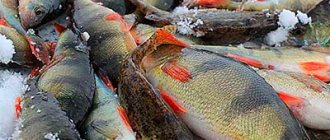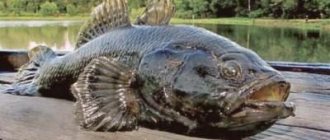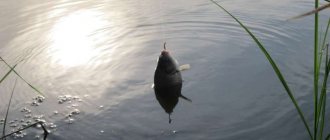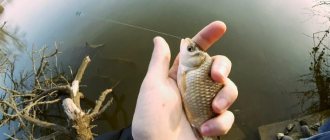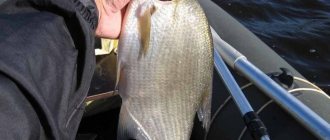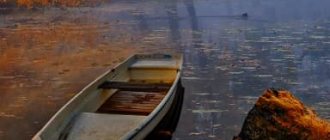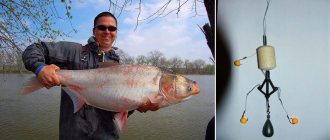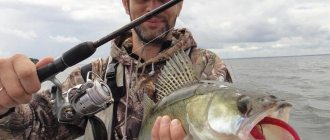Fishing for pond carp in October
As you know, carp is a domesticated carp, which can be bred in ponds and private reservoirs.
The size of such an inhabitant reaches impressive sizes, and the weight of large individuals exceeds ten kilograms. Based on this, it is easy to guess that carp fishing is a very exciting activity, accompanied by a lot of unforgettable emotions and impressions. Read also: Fishing for carp with corn Carp can be successfully caught until mid-October, until the water cools down to 14 °C. But even at this temperature, or even much lower, rare bites still occur in the daytime. But if it bites, it is almost always a large specimen.
Carp is an unpretentious fish and, as they rightly say, is an omnivore. The closest relative of the carp, carp is strong and hardy. It grows quickly. Moreover, it does not make particularly high demands on the body of water in which it has to swim. It’s hard to say where today more carp live, in wild ponds or in cultural fish farms - so many of them, these farms breeding carp, have proliferated recently. The fact that the carp on store shelves comes from fish farms is understandable. But I still hope that quite a few individuals inhabit old abandoned ponds and lakes. And carp is also a frequent guest in rivers. Cooking delicious: Hungarian carp soup
And although carp is a heat-loving fish, in October it is not afraid of even the first frosts, which is explained by the need to gain fat and stock up on energy for the upcoming winter. It is known that already in the second year of life such a representative of the ichthyofauna weighs 800 grams. In general, this fish can grow to almost 1 m in length and weigh 10–12 kg. In the so-called brood ponds at fish farms, 15-kilogram hulking giants are sometimes found, but these are exceptional cases. There are three main subspecies of carp: scaly carp (most often found in nature), mirror carp (which has scales only at the top and bottom along the body) and naked carp (which has no scales at all).
Carp does not show any special requirements when choosing a food source. It freely eats both plant and animal food, arranging special feeding places in aquatic thickets.
Gear selection
Donk fishing is considered effective (and it is better to cast 10-20 donks). An important condition is the choice of strong and high-quality gear, since carp is characterized as a strong, careful and intelligent fish.
Fishing for carp using a skewer is preferable for medium-sized bodies of water with standing water. Makushatnik is a semi-finished product (briquettes) from waste obtained during the production of sunflower oil. This method is mainly used when catching the type of fish in question. Some fishermen additionally spray the carp with a honey or garlic flavoring.
The top hook needs to be attached to a sinker (the equipment used can be either sliding or blind) and several (from 4 to

It should be noted that fishing for carp using flyfish is recognized as an inhumane method and is illegal in some European countries.
Many anglers (including those who do not like to fish from a boat) choose a feeder. Feeder rods are used for fishing in the depths of the bottom of a reservoir (at a distance from the shore). For fishing you need to use strong rods that allow you to cast heavy feeders. It is recommended to use “running” types of rigs, since carp fishing in the fall requires caution: if the fish feels the resistance of the bait, it will most likely abandon it. Thus, gear for carp fishing in the second autumn month can be as follows:
- classic donks;
- feeder;
- makushatnik.
A float rod is ineffective when cold weather sets in. You can use such tackle if you have a boat: in this case, it becomes possible to get close to any part of the reservoir and silently cast.
The subtleties of carp fishing on a pond
There are different ways to catch carp in October:
- float rod
- bottom gear.
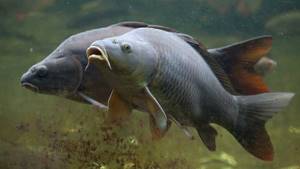
The arrival of autumn cold helps to lower the water temperature, as a result of which favorite food ends up at the bottom and hides in the silt. Carp follow them, so it is better to look for them in the bottom layers of the reservoir. A key feature of carp fishing in October is the need to constantly change the casting location. Unlike the summer season, when the fish constantly moves around the reservoir, in the fall it settles in wintering pits and rarely spends energy on long walks in search of food. This is interesting: How to choose a tent for carp fishing
In most cases, a good fish bite is observed in the coastal zone, where the water temperature is still relatively high. But in order to get the carp to bite in such a place, you need to remain quiet and choose the most sensitive gear. It also wouldn’t hurt to conduct a preliminary study of the bottom topography, depth and other features of the water area.
Fishing methods and bait
Three methods are considered traditional when fishing for carp:
- Carp bottom tackle
- Feeder
- Float rod
There are all sorts of other methods of fishing with slings, with homemade carp rigs with hooks, and fishing for carp with donks with many rods, but all of them almost exclude the possibility of catch-and-release fishing, and are also much less sporting. In general, lines are often placed with violations, many times exceeding the permitted number of hooks per fisherman, even if the line is set by two people, and this is more like industrial harvesting of fish with varying degrees of success.
Fishing for carp involves the use of bait. Of course, in cold water the carp will react much less to it. But we’re not talking about fishing in icy water when the carp doesn’t bite, is it? Up to 10-12 degrees, the bait continues to work normally, actively attracting fish. And even when the temperature drops, it will work not to attract, but to retain fish. When passing by and finding a feeding area, the carp will simply stay there longer, eating the food, and there will be a chance to get it on the hook. And if there is no bait, then the chance of noticing a small boilie or bait on the hook will be minimal, and the carp will simply pass by without stopping.
For bait, dry and various cereals are traditionally used. Carp responds well to soybean cake and soybean meal. Edible soy sauce is a very effective flavor additive that carp respond well to in the fall. You can also use well-steamed peas, mashed potatoes in groundbait, corn porridge, bran, and other additives. Their effectiveness very much depends on the reservoir where the fish are caught, as well as on the preferences of the fish in a particular place. As with anything else in fishing, you have to search, experiment, try... Well, if you find it, then you fish it in a proven way, using proven bait.
The effectiveness of bait, especially in autumn, increases with the addition of an animal component, as well as large particles such as pellets, corn grains, and feed for livestock. The fact is that carp instinctively searches for large particles at the bottom and is not very tempted to rummage through a smeared bait spot, even if it smells good. He tries not to put too much strain on his digestion in cold weather, so that less silt gets into his stomach with food, and he takes into his mouth only what seems most tasty to him. Therefore, pellets, worms, maggots added to the bait can hold it for a long time, and in the bait spot formed by one extruded dry bait, which has collapsed into a liquid slurry, it will stand, but not finding large particles, it will leave. The animal component is also good because it moves on the bottom and this also attracts fish.
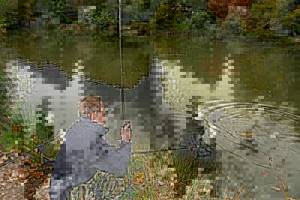
Fishing with carp tackle
English-type carp tackle is not as common in our country as a feeder, and even more so a float rod. However, this type of gear is most suitable for catching carp both in currents and in still water. It involves the use of various types of fishing rods for baiting, for marking the place of fishing and exploring the bottom, and directly for fishing separately. They are all similar in appearance - it is a 2.5-4.2 meter long rod with a spinning reel, but in terms of structure and equipment they have serious differences. Fishing for carp in October on a pond or on a platform is usually done using the classic English carp method. This method is also used in November and December.
It is customary to distinguish between marker, spod and working rods. A marker rod is designed to study the bottom of a reservoir in order to identify promising areas, pits at depth, identify the nature of the soil, etc. It is equipped with a special marker sinker and only a cord, as well as a marker float. After the bottom has been explored and a good area has been found, mark the distance to the casting point and a landmark so that it can be repeated, and set up a marker float. Throw the fishing rod again into the same place and feed along the marker float.
Victoria Leshchenko
I've been working hard in the fishing tackle department for the past six years. I can help you assemble almost any gear.
Ask a Question
A spod rod is used for bait. It is quite rough, designed for long casts of a heavy feeder. It is usually also equipped with a cord. A special spod feeder - a rocket - is capable of delivering a lot of food in a limited amount of time, and can also accommodate and unload large particles, worms, and other large components.
For fishing, use a working rod with carp equipment. It is a sliding carp-type sinker, to which a leash with a hook and a fishing line are attached. Sometimes, instead of a regular sinker, a “method” type feeder is used, but the classic is a regular weight without a feeder, because initially a large amount of bait is assumed, which can be added with a spod rod, and the feeder in this case will not be so effective. You can watch the video below and enjoy the moments of bites.
It is of great importance here how to correctly deliver the bait to the carp fishing point. If fishing takes place far from the shore, in the middle of the pond, the classic carp cast is to let the weight fly slightly over the marker float. Then the nozzle is pulled up to the level that is set with a special marker on the fishing line. Use marker rubber or dye markers, the first is suitable for cord, the second - if you use monofilament. This method allows you to catch quite accurately in a strictly defined place that was baited. The feeder has a slightly different technology for achieving casting accuracy, and it consists of clipping the line on the reel.
Classic carp hair rig. A special hair leash is attached to the hook, and a boilie is installed on it - a special floating attachment. Boilies can be purchased at the store or made yourself. There are many subtleties in preparing boilies. In fact, a hair rig is a boilie that floats in the water, attached to a hair leash to a hook and a hook that hangs just below the boilie held by the hair. The carp quickly finds such a bait and willingly takes it. He swallows the boilie, takes it into his throat without feeling the hair. The hook in this case is located in the area of his lips, and he, trying to spit it out and at the same time swallowing the boilie, usually hooks himself.
When fishing on a “method” type feeder, the boilie is initially pressed into it along with the food. Since the feeder is open, when the food washes away, it jumps out of the bait and floats up. Underwater, this creates a characteristic sound that is heard by the fish, and it takes the bait.
It is worth mentioning the main feature of carp fishing reels - the presence of a baitrunner. A carp weighing more than 5 kg can easily drag a rod far into the water, and the angler will lose both it and his catch. And such instances are not uncommon.
This type of English carp fishing is a classic one, practiced in large open reservoirs with standing water and pay zones. In our conditions, carp are often caught in the current, not at a very large distance from the shore. For example, in numerous canals of a shipping or irrigation system, in rivers. In these areas there is current and the marker float will not be as effective as in still water. In addition, the fishing distance is usually short. You can get by with a shorter rod without a shock leader and a long-casting system. Yes, and feeding can be done simply by hand, throwing balls with bait.
This simplified version allows you to use only one rod. When fishing in the Astrakhan region in the eriks of the Volga, in reeds and reed channels, it is very effective. It can be tested in the canals of the Krasnodar Territory, in the tributaries of the Volga, Don and other reservoirs of a similar type, where it is not far from bank to bank. If you want to catch carp in the current at a longer distance, feeder fishing is more suitable.
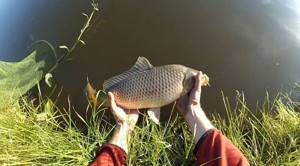
Fishing on a feeder
This kind of fishing is most favorable when carp are caught at a distance of more than 30-40 meters from the shore in the current. A fairly rigid “hard” type rod is used, even when not too heavy loads are used. Firstly, such a rod will allow you to throw even not very large spod feeders into the fishing spot, making a large starting feed quickly and efficiently. Secondly, such a rod will allow you to cope with heavy carp, the weight of which can reach more than 15 kilograms, and they resist very actively when fishing.
You can use a traditional feeder, or use a “method” type feeder. The latter is preferable for fishing with hair rigs and boilies. With a regular feeder, traditional feeder installations are often used - paternoster, inline, symmetrical loop. When using a cord, it is advisable to also use a shock leader, since the line on the shock leader with its elasticity dampens the jerks of the fish. Of course, it is necessary to be able to install two feeders: for feeding, a larger one, and for direct fishing, not so large. A traditional feeder is often used when fishing with worms, beetle larvae or other animal baits in the fall, for example, when carp are caught with shrimp. In some places, the bite is most effective with this kind of bait.
Fishing with a carp feeder allows you to expand the capabilities of this gear. For many feeder anglers, catching carp in the fall means catching the biggest fish of the season, as the size of the fall carp is impressive. The feeder has some disadvantages compared to a carp rod, but in general it allows you to catch carp on large rivers more effectively than other gear.
Float rod
The most beloved and traditional tackle in any region of the CIS. Carp on a float is an unforgettable experience! Both carp and crucian carp are caught in the fall, and when the water cools enough, the rod can be reconfigured from catching larger carp to smaller crucian carp in the same places. The long rod itself allows you to feel well all the jerks of the fish in the water, all its behavior on the hook. And the float - you can even track down to the smallest detail how the carp will bite.
As is already becoming clear, you need to use very durable fishing rods designed for carp fishing. Typically, a float rod of this type has a slow action and is made of low-modulus graphite. The length of the rod is up to six meters. It will be difficult to handle a longer stick of similar strength, as it will have incredible weight. It is also not recommended to use cheap fiberglass float rods. The best choice is not too cheap rods with ali, which are called carp rods. In China, carp fishing with a float rod is no less popular than in the CIS countries, and even more so. Their industry produces very good sticks suitable for this purpose.
The fishing rod must be equipped with guides and a reel. The reel can be used either inertial or non-inertial. An inertial one is preferable because it will be easier to control, it can withstand heavier loads and has a low gear ratio, making it easy to reel in the line if it has been lost under the pressure of the fish. The rings on the rod must be of high quality, their legs must be completely covered with varnish and have no protruding parts. It is this kind of rod that allows you to fish effectively both in drizzling rain, when the line sticks to it, and in good weather.
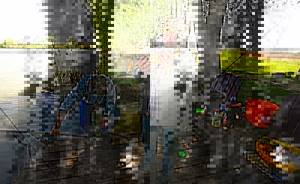
The rod is equipped with a fishing line and a fairly clearly visible float. It must be installed on the stand at such an angle that the carp cannot drag it away, and it must be secured in some other way. It’s simply impossible to hold such a stick in your hand all day long, so a stand is a must-have, and not just any kind, but a well-thought-out one. Many anglers, after installing the rod, move away from the water so as not to spook the carp with their presence on the shore.
This is done not only by floaters, but also by carp fishermen. They assure that the carp sees well, and before starting to feed, it carefully looks around to see if there is anyone on the shore. However, you don't need to go too far. There is a risk of simply not seeing the bite on the float from a long distance and being late with the hook.
Bait in October for carp
For effective fishing in October, you need to find a suitable bait mixture and intensively feed the promising area. Experienced fishermen advise throwing 10-15 kg of complementary food into the water per day. In addition, it is recommended to treat the selected place for several days so that the carp will fall in love with it and stay for a long time. The prepared mixture should emit an intense aroma and contain a lot of nutritious ingredients.
Compositions based on corn, potatoes and cereals are in particular demand, due to their aromaticity and nutritional value. However, they cannot be called a universal option, because... In each body of water, fish display their gastronomic preferences in different ways. When choosing bait, the situation is exactly the same, because if in one place the carp is interested in the earthworm, then in another it is exclusively interested in potatoes. Fishing story: The difficult fate of the wise carp
Carp tackle
To catch carp in October, you should use reliable and strong gear that can cope with impressive jerks and withstand heavy loads. In addition, you will have to constantly re-cast the bait.
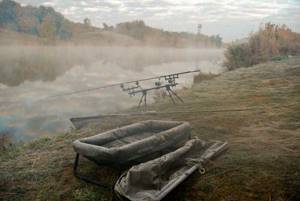
When choosing gear, you should give preference to models that provide long-range fishing and do not interfere with the passage of the fishing line along a specific route. Carp are cautious inhabitants of the depths, so the equipment should be as inconspicuous as possible. In October, a running rig is popular, as it allows you to cast bait over a considerable distance. As for the thickness of the fishing line, it is determined by the size of the expected trophy and can range from 0.25 mm (monoline), when using high-quality and balanced gear. Fishing story: Every carp is like a trough
The length of a carp rod is 2.5-3 meters for boat fishing. It is advisable to use match forms, which are characterized by increased sensitivity and allow you to respond to any bite, even the most insignificant. In addition, the tackle must be additionally equipped with a bite alarm, which will notify you of a bite that has occurred.
Carp fishing time in October
The duration of the carp bite in October is noticeably different from the summer. The activity of the fish becomes inconsistent, and this applies to both small and large individuals. It is better to start fishing in the evening and continue the whole night, when the prey stays near the reeds. It is very good if the fisherman managed to find a wintering hole with a slight current and impressive depth. In such a place, carp will bite throughout the autumn season and even in winter, during the thaw period. It is worth remembering that night fishing for carp in October is less successful than daytime fishing. As the weather gets colder, the bite is not uniform throughout the day, but active carp hatches still occur. It’s not too late to hunt for carp, although they bite less and less confidently.
Catching carp with various boilies is also successful when bait boilies (in the required quantity) are delivered to the place where the donkey is cast. Sometimes the effect of bait is achieved by combining whole boilies with a part of crushed boilies, which spread a stronger smell in the water and attract carp from afar.
The queen of the fields, corn, is also not the last delicacy on the fish table. In the old days, anglers as active as today did not use corn as bait, but when fishing on cultivated carp ponds became popular, canned Bonduelle corn came into play. I must say that carp really bite well on this bright and fragrant bait, and it’s easy for an angler to use - open a can with a can opener and place the grains on the hook.
October carp
Carp is a domesticated carp that owners of paid reservoirs love to breed. They breed several types of them - scaly, mirror, etc. However, whatever the fish, carp fishing in October is an exciting thing! Although carp loves warmth, on the eve of winter it begins to actively feed and gain fat. By the second year of life, the weight of the carp reaches 800 grams, and the world record for the caught carp is an individual weighing 120 kg.
Carp is very unpretentious in food, feeding on plant and biological food, preferring to stay in aquatic thickets.
